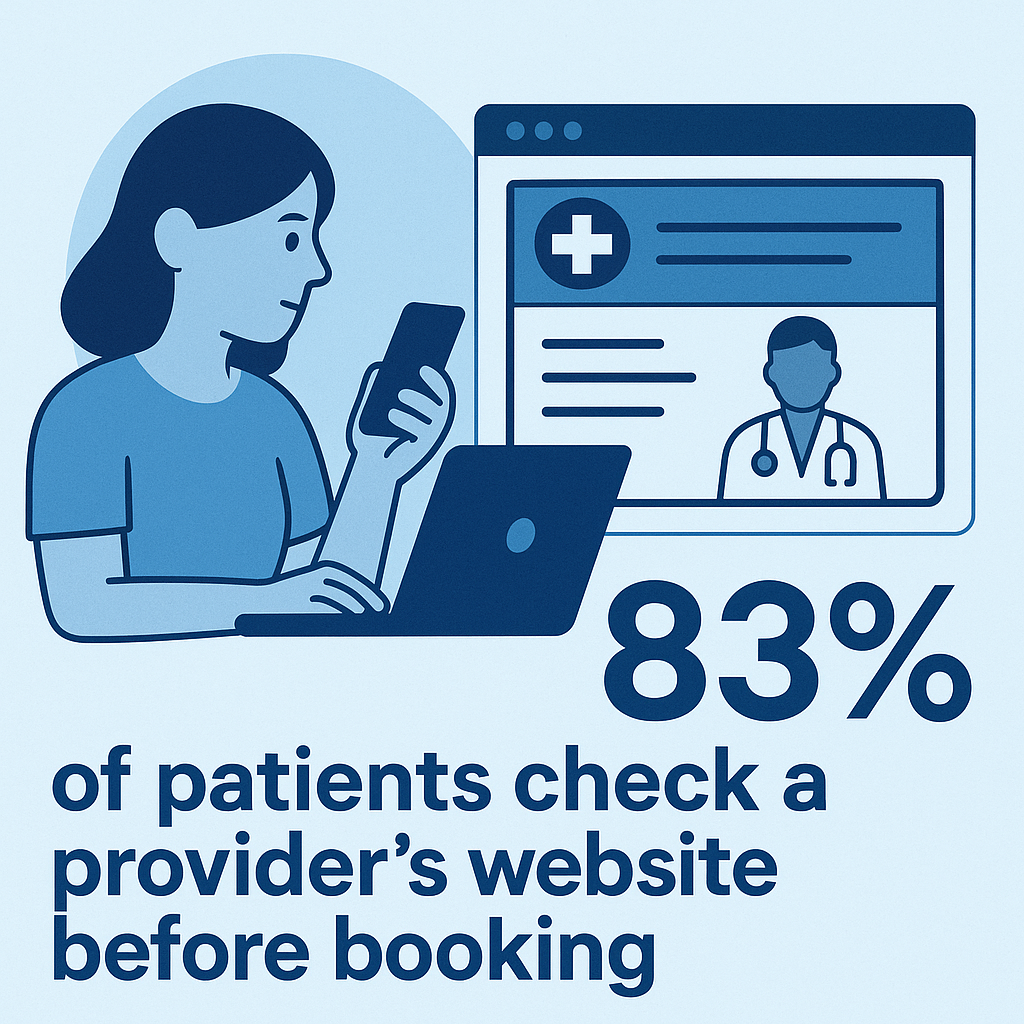In 2025, medical website design is more critical than ever, as it’s not only the digital front door of your practice but also your 24/7 patient acquisition engine. With 83% of patients checking a provider’s website before booking, having a well-designed site can be the difference between gaining or losing patients (DigitalisMedical). To build trust instantly, medical websites must integrate essential features that cater to patients’ needs effortlessly. From ensuring secure healthcare data management with HIPAA-compliant patient portals to adopting a mobile-first design, every element plays a crucial role. Furthermore, elements that foster trust, enable seamless appointment booking, and offer educational content are key components that transform visitors into loyal patients. Get ready to enhance your online presence and convert clicks into appointments by optimizing your website with these five must-have features.
HIPAA-Compliant Patient Portals
In the realm of medical website design, HIPAA-compliant patient portals are not just an add-on; they are essential. By implementing a portal that adheres to HIPAA standards, you ensure that patient information remains confidential, building trust from the first digital interaction.
Secure Login Systems
Secure login systems are a cornerstone of any patient portal. They guarantee that only authorized individuals have access to sensitive information. Two-factor authentication and encrypted connections are not optional but necessary to prevent unauthorized access. By employing advanced security measures, you create a safe digital environment for patients to interact with your practice.
Electronic Health Record Access
Electronic health record (EHR) access enables patients to view their health history, lab results, and treatment plans effortlessly. This feature empowers patients, allowing them to take an active role in their healthcare journey. By offering easy access to EHRs, you enhance patient engagement and satisfaction, making your practice more desirable.
Online Appointment Scheduling
Online appointment scheduling simplifies the administrative process both for your practice and your patients. This feature allows patients to book appointments through their patient portal at any time, without needing to make a call during office hours. Reducing barriers to booking means increased appointments and better care continuity, crucial for medical website design.
Prescription Refill Requests
Prescription refill requests through the portal optimize medication management. Patients can request refills easily, ensuring they adhere to their treatment plans without unnecessary delay. This seamless service boosts patient loyalty as they can manage their health needs efficiently and receive timely pharmaceutical support.
Encrypted Messaging Systems
Encrypted messaging systems are essential for secure communication between patients and healthcare providers. Through the patient portal, patients can send messages to their providers without worrying about privacy breaches. This secure line of communication facilitates prompt responses, enabling better care coordination and fostering a closer patient-provider relationship.
Mobile-First Design
In the fast-paced digital world, mobile-first design is crucial for the success of your medical website design. With more users accessing websites from their mobile devices, your design must cater to mobile users without compromising on speed or usability. Here’s how you can ensure a seamless mobile experience for your patients.
Lightning-Fast Load Times
Speed is of the essence when it comes to a medical website. Slow load times can turn potential patients away, leading to missed opportunities and a drop in patient acquisition.
Importance of Load Speed
Imagine a patient in need of urgent information navigating to your website only to be met with a loading icon spinning endlessly. This scenario underscores the importance of load speed. Studies show that if a website page takes more than 3 seconds to load, over half of mobile users will abandon it. For a medical practice, this delay could mean the difference between gaining a new patient and losing one to a faster competitor.
Learn Everything You Need To Know About Technical SEO with my in-depth guide.
Optimizing Load Speeds
To improve load speeds, consider optimizing your website’s images, utilizing browser caching, and minimizing HTTP requests. Reducing the size of images and compressing content can dramatically speed up your site. Additionally, enable browser caching to load previously visited pages faster. Implementing a Content Delivery Network (CDN) can also distribute the load more efficiently, ensuring that your content reaches users more quickly.
Touch-Friendly Navigation
Touch-friendly navigation ensures that users can easily navigate your medical website design on a mobile device. With the growing use of smartphones and tablets, your website must have larger buttons, minimal text input, and intuitive scrolling. This feature enhances the user experience, allowing patients to find the information they need easily.
Responsive Layouts
Having responsive layouts is paramount. Your medical website design should seamlessly adjust to any screen size, from the smallest smartphone to the largest desktop. A responsive design improves accessibility and ensures that users enjoy a visually appealing experience regardless of the device they use.
Click-to-Call Functionality
Click-to-call functionality is a convenient feature that can greatly impact your conversion rates. Allowing users to call your practice directly from the website with a simple tap can lead to faster communication with potential patients. This feature eliminates the barrier of typing in a phone number, streamlining the process for scheduling appointments and inquiries effectively.
Also consider implementing these 2025 Mobile Web Design Trends.
Quick Tip: Always test your mobile-first designs on various devices to ensure compatibility and usability.
Trust-Building Elements
Trust-Building Elements are critical for transforming visitors into patients on your medical website. These elements give your practice an air of credibility and reliability at first glance. Let’s delve into how each of these components can create a trustworthy online presence for your medical practice.
Display Provider Credentials
Displaying provider credentials prominently is vital for medical website design in 2025. When potential patients visit your site, they need to see the qualifications and expertise of your healthcare providers right away. Make sure to include not just their educational background but also any specialized training, certifications, and professional memberships they hold.
Note: Trust is significantly fortified when visitors can easily verify the credentials of your medical staff. This quick check reassures them about the quality of care they can expect.
Patient Testimonials
Patient Testimonials provide potential patients with first-hand insights into your practice. Written testimonials are powerful, but nothing beats the impact of seeing and hearing real patients share their stories. Video Testimonials, in particular, can be a game-changer.
Impact of Video Testimonials
The Impact of Video Testimonials is profound in the digital world. They offer a genuine glimpse into patient experiences, humanizing your practice and establishing trust with viewers. Video testimonials allow potential patients to form an emotional connection, seeing real people with similar concerns who have found relief and care at your practice.
Videos can be more engaging and can convey trust more effectively than text-based testimonials.
Insurance Information
Clear Insurance Information is a must-have for a medical website design. Patients need to know whether they can use their insurance with your practice to avoid unexpected costs. Providing thorough and easily accessible insurance details ensures that visitors have all the information they need before making a decision.
Make sure to update insurance information regularly to keep it all accurate and current.
Pricing Transparency
Pricing Transparency is becoming increasingly important. Patients want to know what they might pay for services before even considering an appointment. Offering a clear, straightforward explanation of your pricing policies helps eliminate surprises and fosters trust.
Displaying prices and potential costs upfront can differentiate your practice in a positive way, showing that you are open and honest about your services.
Professional Photos
Professional Photos on your website of staff and facilities can greatly enhance trust. High-quality images create a warm, welcoming image of your practice and give patients a view of the environment they’ll experience.
Consider a virtual tour or gallery to give visitors a real feel of your practice. Visuals are a quick way to communicate the professionalism and friendliness of your clinic.
By integrating these Trust-Building Elements effectively, your medical website can establish genuine credibility and foster patient trust, leading to increased appointments and satisfied visitors.
Seamless Appointment Booking
Effective appointment booking is vital for any medical practice aiming to enhance patient experience and management efficiency. By integrating seamless appointment booking processes, practices can significantly improve patient satisfaction and streamline their operations.
Real-Time Availability
Real-Time Availability is crucial for providing an efficient and hassle-free booking experience. When patients visit your website, they should have immediate access to current appointment slots. This transparency reduces the back-and-forth communication often required to find a suitable time slot. This is key for great medical website design.
Imagine a patient needing a specific date and time – being able to see what’s available instantly can solidify their choice to book with your practice.
Insurance Verification
Insurance Verification at the appointment booking stage is another game-changer. Patients appreciate the ability to verify their insurance coverage during the booking process, saving them time and reducing stress.
By integrating an insurance verification system, your practice can prevent scheduling appointments with insurers you don’t cover, enhancing the overall patient booking experience.
New Patient Forms
Streamlining the intake process starts with allowing patients to fill out New Patient Forms online before their first visit. This feature saves time for both patients and staff. Patients can complete necessary paperwork at their convenience, ensuring they’re not feeling rushed upon arrival.
For the practice, this means better preparedness for each appointment and less paperwork on the day of the visit.
Appointment Reminders
Appointment Reminders are critical in reducing no-shows and cancellations. Automating reminders via email or SMS helps patients remember their appointments and confirms their intent to attend.
Such reminders should be customizable to work best with your patient demographic, whether that means sending them one day or one week before the appointment, depending on your clinic’s policy.
Multiple Booking Options
To cater to various user preferences, offering Multiple Booking Options is essential. Patients should be able to book appointments through different channels, such as over the phone, via email, through an online portal, or even using a mobile app.
Providing these options ensures you don’t lose potential patients who may prefer one method over another, maximizing your practice’s ability to accommodate diverse patient needs.
Content That Educates
Creating engaging and educational content on your medical website design not only informs patients but also enhances trust and encourages them to choose your practice.
Condition-Specific Resources
Condition-specific resources provide detailed information about various health issues, helping patients understand their conditions better. These resources can include articles, brochures, or fact sheets that are carefully curated to be accurate and easily digestible. By offering such resources, you show commitment to patient education, which can significantly increase patient confidence in your expertise.
Treatment Explanations
Clear and thorough treatment explanations are essential for patients to make informed decisions about their health care. Providing detailed yet simplified explanations of treatments helps demystify medical procedures and alleviates patient anxieties. Ensure that explanations are easy to understand and free of medical jargon, possibly supplementing text with infographics or illustrations to aid comprehension.
FAQ Sections
FAQ sections are a must-have feature, addressing common patient questions efficiently. Well-organized FAQs save time for both staff and patients by providing quick answers to frequent inquiries about appointments, billing, procedures, and other relevant topics. Regularly updating this section with new questions can help keep it relevant and incredibly useful.
Blog Updates
Regular blog updates serve as a dynamic way to provide fresh and relevant health information to your audience. Blog posts can cover a range of topics, from health tips and medical news to personal stories from your practice. Consistent blogging demonstrates authority in your field and can drive traffic to your site, helping to capture the interest of new patients while re-engaging current ones.
Video Content
Video content is a powerful tool for engaging patients with informative and visual messages. From patient testimonials and facility tours to detailed breakdowns of medical procedures, videos can make complex information more accessible and appealing. Videos are often more memorable than text, and they cater to different learning preferences, thus broadening the reach and impact of your educational content.

